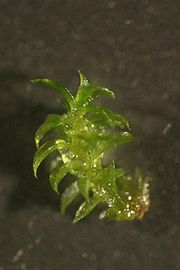
Gametophore
Encyclopedia

Moss
Mosses are small, soft plants that are typically 1–10 cm tall, though some species are much larger. They commonly grow close together in clumps or mats in damp or shady locations. They do not have flowers or seeds, and their simple leaves cover the thin wiry stems...
and fern
Fern
A fern is any one of a group of about 12,000 species of plants belonging to the botanical group known as Pteridophyta. Unlike mosses, they have xylem and phloem . They have stems, leaves, and roots like other vascular plants...
(Archegoniata) the gametophore is the bearer of the sex organs (gametangia
Gametangia
A gametangium is an organ or cell in which gametes are produced that is found in many multicellular protists, algae, fungi, and the gametophytes of plants...
), the female archegonia and the male antheridia. If the archegonia as well as the antheridia are arranged at the same plant, they are called monoecious. If there are female and male plants they are called dioecious
Dioecious
Dioecy is the property of a group of biological organisms that have males and females, but not members that have organs of both sexes at the same time. I.e., those whose individual members can usually produce only one type of gamete; each individual organism is thus distinctly female or male...
.
In Bryopsida
Bryopsida
The Bryopsida constitute the largest class of mosses, containing 95% of all moss species. It consists of approximately 11,500 species, common throughout the whole world....
the leafy moss plant (q. v. "Thallus") is called gametophore. It is the adult form of the haploid gametophyte
Gametophyte
A gametophyte is the haploid, multicellular phase of plants and algae that undergo alternation of generations, with each of its cells containing only a single set of chromosomes....
and develops from the juvenile form, the protonema
Protonema
A protonema is a thread-like chain of cells that forms the earliest stage of a bryophyte life cycle...
, under the influence of phytohormones (mainly cytokinins). Whereas the filamentous protonema grows by apical
Apical
Apical, from the Latin apex meaning to be at the apex or tip, may refer to:*Apical , an anatomical term of location for features associated with the base of an organism or structure...
cell division, the gametophore grows by division of three faced apical cells.

